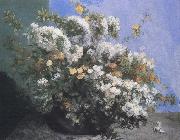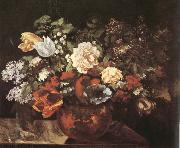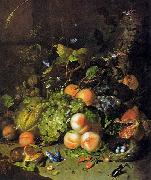
Oil On
Canvas, Real Flavor of Old Masters
|
Nikolay Fechin
|
|||
|
|
|||
| Russian, 1881-1955 | |||
|
|
|||
| This artist (Nikolay Fechin) is not available now. | |||
|
|
|||
|
Gustave Courbet
|
|||
|
|
|||
| 1819-1877 French Gustave Courbet Locations was a French painter whose powerful pictures of peasants and scenes of everyday life established him as the leading figure of the realist movement of the mid-19th century. Gustave Courbet was born at Ornans on June 10, 1819. He appears to have inherited his vigorous temperament from his father, a landowner and prominent personality in the Franche-Comte region. At the age of 18 Gustave went to the College Royal at Besancon. There he openly expressed his dissatisfaction with the traditional classical subjects he was obliged to study, going so far as to lead a revolt among the students. In 1838 he was enrolled as an externe and could simultaneously attend the classes of Charles Flajoulot, director of the ecole des Beaux-Arts. At the college in Besançon, Courbet became fast friends with Max Buchon, whose Essais Poetiques (1839) he illustrated with four lithographs. In 1840 Courbet went to Paris to study law, but he decided to become a painter and spent much time copying in the Louvre. In 1844 his Self-Portrait with Black Dog was exhibited at the Salon. The following year he submitted five pictures; only one, Le Guitarrero, was accepted. After a complete rejection in 1847, the Liberal Jury of 1848 accepted all 10 of his entries, and the critic Champfleury, who was to become Courbet first staunch apologist, highly praised the Walpurgis Night. | |||
|
|
|||
|
|
Flower new20/Gustave Courbet-496658.jpg Painting ID:: 55530 Visit European Gallery |
mk242 1855 Oil on canvas 84x109cm | |
Height Width |
INS/CM |
||
|
X |
|
||
|
|
|||
|
Gustave Courbet
|
|||
|
|
|||
| 1819-1877 French Gustave Courbet Locations was a French painter whose powerful pictures of peasants and scenes of everyday life established him as the leading figure of the realist movement of the mid-19th century. Gustave Courbet was born at Ornans on June 10, 1819. He appears to have inherited his vigorous temperament from his father, a landowner and prominent personality in the Franche-Comte region. At the age of 18 Gustave went to the College Royal at Besancon. There he openly expressed his dissatisfaction with the traditional classical subjects he was obliged to study, going so far as to lead a revolt among the students. In 1838 he was enrolled as an externe and could simultaneously attend the classes of Charles Flajoulot, director of the ecole des Beaux-Arts. At the college in Besançon, Courbet became fast friends with Max Buchon, whose Essais Poetiques (1839) he illustrated with four lithographs. In 1840 Courbet went to Paris to study law, but he decided to become a painter and spent much time copying in the Louvre. In 1844 his Self-Portrait with Black Dog was exhibited at the Salon. The following year he submitted five pictures; only one, Le Guitarrero, was accepted. After a complete rejection in 1847, the Liberal Jury of 1848 accepted all 10 of his entries, and the critic Champfleury, who was to become Courbet first staunch apologist, highly praised the Walpurgis Night. | |||
|
|
|||
|
|
Flower new20/Gustave Courbet-248996.jpg Painting ID:: 55594 Visit European Gallery |
mk242 1862-1863 Oil on canvas 51x62cm | |
Height Width |
INS/CM |
||
|
X |
|
||
|
|
|||
|
Rachel Ruysch
|
|||
|
|
|||
| Dutch 1664-1750 Rachel Ruysch (June 3, 1664 ?? Amsterdam, August 12, 1750) was a Dutch artist who specialized in still-life paintings of flowers. She was born in The Hague, but moved to Amsterdam when she was three. Her father Frederik Ruysch, a famous anatomist, and botanist, was appointed a professor there. He gathered a huge collection of rarities in his house. She assisted her father decorating the prepared specimen in a liquor balsamicum with flowers and lace. At fifteen Ruysch was apprenticed to Willem van Aelst, a prominent Delft painter, known for his flower paintings. In 1693, she married a portrait painter, Juriaen Pool (1666-1745), with whom she had ten children. Her sister Pieternel was married to Jan Munnicks, a young man who drew flowers in the Hortus Botanicus Amsterdam. In 1701 Ruysch was inducted into the painters' guild in The Hague. Several years later Ruysch was invited to work for the court in D??sseldorf and serve as court painter to Johann Wilhelm, Elector Palatine. She remained working for him and his wife from 1708 until the prince's death in 1716. Also Jan Weenix and Adriaen van der Werff were invited to deliver paintings, after Eglon van der Neer died. In 1723 she won the lottery. Ruysch kept painting for her prominent clients. Ruysch lived eighty-five years and her dated works establish that she painted from the time she was a young woman until she was an octogenarian. About a hundred paintings by her are known. The background of the paintings are usually dark. Ruysch was also noted for her paintings of detailed and realistic crystal vases. | |||
|
|
|||
|
|
Flower new24/Rachel Ruysch-449677.jpg Painting ID:: 75888 Visit European Gallery |
Medium Oil on canvas Dimensions 93 ?? 74 cm (36.6 ?? 29.1 in) cyf | |
Height Width |
INS/CM |
||
|
X |
|
||
|
|
|||









